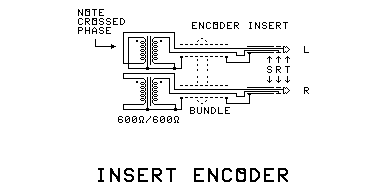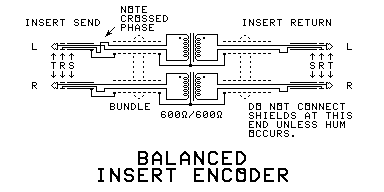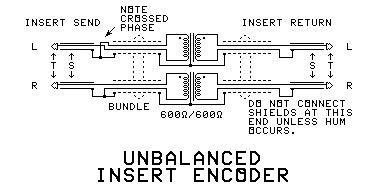


- You will need the following in addition to the plugs and cables:
- 2 identical 600 ohm to 600 ohm audio isolation transformers
- 1 small plastic box to mount them in.
- Grommets or strain reliefs.
- Either a ready-made grid PC board or some solder-lug terminal strips to mount parts on.
- Remember that when you are told: "DO NOT connect the shield" that it should be trimmed off and insulated with tape or shrink tubing to prevent contact.
- Find the marking that indicates the primary winding (usually a blue or black band).
- Mark the hot phase of each winding with a magic marker such that it can be seen after the transformers are mounted. If you can't determine phase, mark the diagonally opposite terminals of both transformers. IMPORTANT! Make sure each mark is on a different winding (use an ohmmeter), and make sure both transformers marked identically.
- Cut a number equal lengths of mic cable long enough to easily reach from your SUB INSERT (or SUB SEND and
RETURN connectors) to where you plan to set the box. Leave 1 or 2 feet extra to allow for putting on the connectors,
wiring the box, extra slack, and eventual repairs. You will need:
- 4 pieces if all of the jacks listed above are single signal.
- 2 if all of the jacks listed above are tip-ring-sleeve inserts.
- Make holes in the box for grommets or strain reliefs, one for each cable you just cut. Make sure they will not interfere with mounting the terminal strips, PC board, or transformers.
- If using terminal strips, mount them to the box. If using a PC board, make mounting holes, but do not mount it to the box until told to. Make sure the transformers will not obstruct the mounting holes.
- Mount the transformers to the PC board or terminal strips. Be sure the transformer is supported by its mounting lugs, not the connections. Do not mount the PC board yet.
- Connect each transformer lead to a different circuit board pad or solder lug.
- Mark one transformer LEFT and the other one RIGHT.
- Decide on a color code for hot, cold, send, and return. Wire all plugs using the same color code.
- Connect a plug that fits your SUB RETURN connectors to ONE end of cable lengths you just cut as follows:
- If the SUB RETURN jacks are single signal balanced-line, wire TWO cables. Connect them in normal balanced-line fashion, but DO NOT connect the shields. Mark one of the connectors you just put on as LEFT ENCODER RETURN. Mark the other as RIGHT ENCODER RETURN.
- If the SUB RETURN jacks are single signal unbalanced, wire TWO cables. Solder the hot wire to the live terminal, and solder the cold wire to the ground terminal. DO NOT connect the shields at these ends. Mark one of the connectors you just put on as LEFT ENCODER RETURN. Mark the other as RIGHT ENCODER RETURN.
- If the SUB INSERTs are normal tip-ring-sleeve insert jacks (Tip = SEND), wire two cables as normal insert cables. Solder the send wire to the tip, the return to the ring, and the shield to the sleeve. Mark one of the connectors you just put on as LEFT ENCODER. Mark the other as RIGHT ENCODER.
- If the SUB INSERTs are backward tip-ring-sleeve jacks (Ring = SEND), wire two cables as backward insert cables. Solder the return wire to the tip, the send to the ring, and the shield to the sleeve. Mark one of the connectors you just put on as LEFT ENCODER. Mark the other as RIGHT ENCODER.
- Connect plugs that fit your SUB OUT connectors to ONE end of each of the remaining cables:
- If the SUB SENDs are single signal balanced-line, wire TWO cables. Connect them in normal balanced-line fashion. Be sure to connect the shields. Mark one of the connectors you just put on as LEFT ENCODER SEND. Mark the other as RIGHT ENCODER SEND.
- If the SUB SENDs are single signal unbalanced, wire TWO cables. Solder the hot wire to the live terminal, and solder both the cold wire and the shield to the ground terminal. Mark one of the connectors you just put on as LEFT ENCODER SEND. Mark the other as RIGHT ENCODER SEND.
- If the SUB INSERT is tip-ring-sleeve, use the ENCODER cables you made earlier.
- Install the grommets, if used. Do not install any strain reliefs yet.
- Push the free ends of the wires into the proper holes in the box made to receive them.
- If the cables are single-signal (balanced or unbalanced),
- Connect each ENCODER RETURN cable to its marked transformer:
- Solder the hot wire to the secondary hot terminal.
- Solder the cold wire to the secondary cold terminal.
- Connect the shield to the transformer case.
- Connect the ENCODER SEND cables as follows:
- Connect the right cable to its marked transformer first:
- Solder the hot wire to the right primary hot terminal.
- Solder the cold wire to the right primary cold terminal.
- Solder the shield to the transformer case pin.
- Now connect the left cable to its transformer (here's the tricky part):
- Solder the HOT wire to the left primary COLD terminal.
- Solder the COLD wire to the right primary HOT terminal.
- Solder the shield to the transformer case pin.
- Connect the right cable to its marked transformer first:
- Connect each ENCODER RETURN cable to its marked transformer:
- If the ENCODER INSERTs are tip-ring-sleeve cable --
- Solder the LEFT ENCODER RETURN wire to the left secondary HOT terminal.
- Solder the RIGHT ENCODER RETURN wire to the right secondary HOT terminal.
- Solder the LEFT ENCODER SEND wire to the left primary COLD terminal (the tricky part).
- Solder the RIGHT ENCODER SEND wire to the right primary's HOT terminal.
- Solder the LEFT shield to the left transformer case pin.
- Solder a jumper wire from a left transformer case pin to the left secondary COLD terminal.
- Solder another jumper wire from a left transformer case pin to the left primary HOT terminal (tricky part 2).
- Solder the RIGHT shield to the right transformer case pin.
- Solder a jumper wire from a right transformer case pin to the right secondary COLD terminal.
- Solder another jumper wire from a right transformer case pin to the right primary COLD terminal (tricky part 3)
- Mount the PC board, if used.
- Install the strain reliefs, if used.
- Install the box cover.